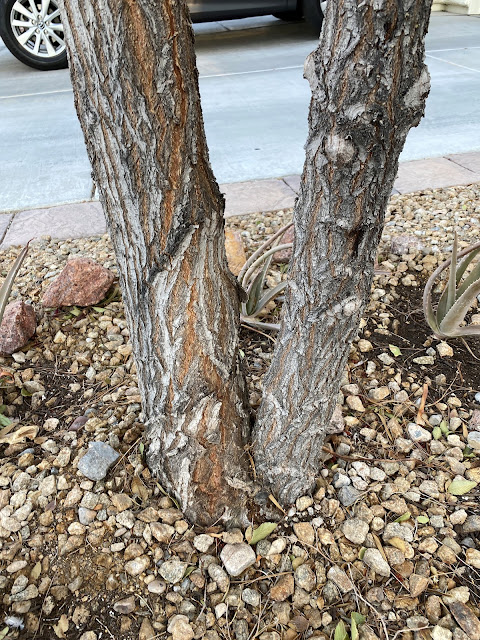Jojoba (Simmondsia californica)
Do you want practice managing a plant that does not need much water by pruning it? Try this Sonoran Desert native plant, Jojoba, and see how you do. I
was introduced to this plant in the mid-1980s when it was getting popular as a
source of oil. It’s again popular but this time because it doesn’t use much
water. Like most desert plants, it responds to watering by growing.
You can read more about this plant here in a post by
Andrea Meckley I published on this blog in 2014.
Details about Jojoba
Growth of this plant is tied very closely to watering
frequency; 1 to 2 inches of water, 3 to 5 times each year. It has the
potential for saving water in the landscape if you know how to water and
prune it. Most fruit trees require about 50 inches of water each year. This
plant grows with 5 to 8 inches of applied water.
·
Unpruned height is nearly 20 feet tall. It grows this tall slowly. Height
can be kept 5 to 6 feet tall if pruned once a year or every other year. Don't prune it from the top with a loppers or hedge shears. Get on your hands and knees and prune it with a loppers or hand shears at the base.
Can it
be grown taller and pruned into a small tree? Perhaps. I haven't tried it. Pruning the lower limbs from this giant shrub(above) might make a nice small patio tree.
·
Evergreen plant unless it gets very cold (lower than 20F) and
then it drops its leaves and becomes deciduous. At very cold temperatures (below 15F) the
top of this plant may die to the ground.
·
Cold temperature limits: 20°F
·
High temperature limits: 125°F +
·
Irrigation: 5 to 8 inches of water each year. Give
it 1 to 2 inches of water in the spring, do that twice in the summer months and
once in the fall. Apply this water in a basin or donut surrounding the tree to
contain the water and reduce water waste. Do not put this plant on an existing
irrigation system or you will be sorry because of it’s growth.
·
Planting location: east side of a building or
wall is best but tolerates full sun (south or west sides) if planted at least 5
feet from a hot surface. Tolerates planting of rock mulch on the surface of the
soil.
·
Spacing from each other or walls: depends on
plants mature height. If grown 20 feet in height than planting distance is no
closer than 15 feet apart (8 feet from a wall). If pruned to 6 feet height,
then plant them no closer than force feet apart (2 feet from a wall).
Male and female plants are wind pollinated much like date palms and corn. If they are propagated by the nursery from seed, then you get 50-50 male and female unless there sexed. If plants are vegetatively propagated (no sex involved) then they will be either all-male or all-female if they came from the same plant. Male plants may cause a pollen problem. Female plants produce the fruit and oil. If these plants are watered too often or the soil has poor drainage, watering frequently on the controller may cause root problems, yellowing and plant death.
Directions for planting Jojoba:
1. Pick
a location for planting, preferably on the east side of your home. The north
and south sides are okay as well but the east side is preferred. Pick a spot
that is at least half the distance from a wall equal to the height you want it
maintained at.
2. Plant
Jojoba (Simmondsia californica) without any drip or supplemental irrigation.
It’s okay to put it into a rock landscape. Build a level basin or donut around
the plant 4 feet in diameter that can hold 2 inches of water. When watering
with a hose, fill this basin or donut only once. Reestablish the irrigation basin
when it no longer holds enough water.
3. Make
the hole for it wide and the same depth as the container or roots. The roots of
this plant need places to spread horizontally easily.
4. Stake
the plant to establish the roots without wind for one growing season and then remove
the stake.
5. After
planting in the spring or fall, wet the soil thoroughly to remove air pockets
and establish the roots.
6. Fertilize
this shrub lightly once a year in the spring or fall or when needed.
7. Manage
this plant’s growth by watering its basin.
8. Prune
this plant at its base or bottom. Never prune this plant at its desired height.
Prune this plant from your knees. Prune this plant by removing long stems (usually 2-4) near its base (renewal or rejuvenation pruning).
Do not prune once a year. Usually not necessary unless it's being watered too often. Every two years, or whenever needed.
Where to get Jojoba?
Check with your local nurseries and see if they haven't first. They usually have some sort of guarantee if it fails. Don't forget to check Lowes or Home Depot as well.
Online nurseries
California online native plant nursery, Las Pilitas
Arizona online nursery, Desert Horizon Nursery
Listing these online nurseries is not an endorsement of any specific nursery. I don't know them. It's just a suggestion.
.JPG)


.jpg)

.JPG)



.JPG)


.jpg)
.JPG)










